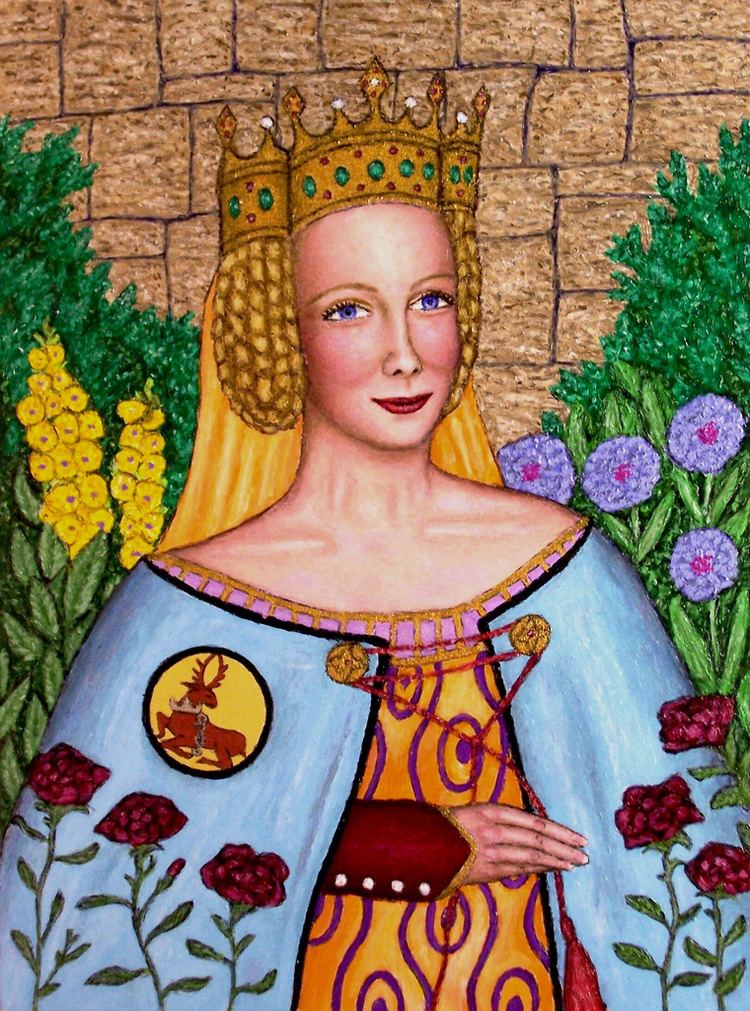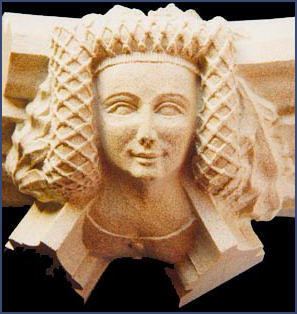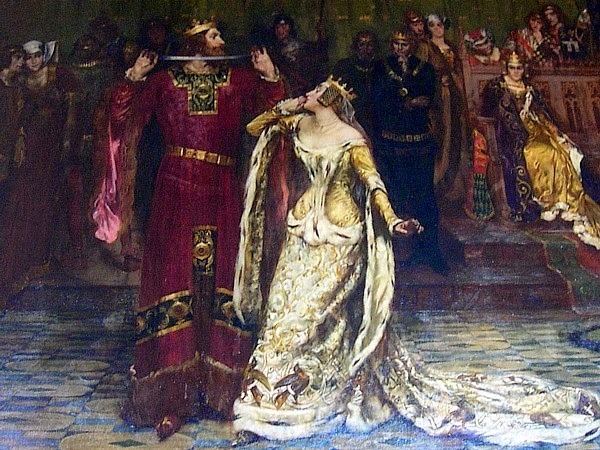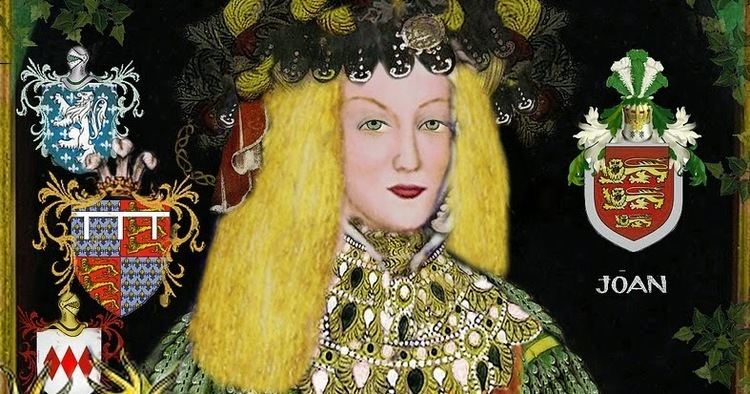Name Joan Kent | ||
 | ||
Born 19 September 1328 ( 1328-09-19 ) Issue Edmund HollandThomas Holland, 2nd Earl of KentJohn Holland, 1st Duke of ExeterJoan Holland, Duchess of BrittanyMaud Holland, Countess of LignyEdward of AngoulemeRichard II of England Spouse Edward, the Black Prince (m. 1361) Children Richard II of England, Thomas Holland, 2nd Earl of Kent Parents Edmund of Woodstock, 1st Earl of Kent, Margaret Wake, 3rd Baroness Wake of Liddell Grandchildren Margaret Holland, Duchess of Clarence Similar People Edward - the Black Prince, Richard II of England, Philippa of Hainault, Edward III of England, Margaret of France - Queen of | ||
Joan of Kent (29 September 1328 – 7 August 1385), known to history as The Fair Maid of Kent, was the mother of King Richard II of England, whom she bore to her third husband Edward, the Black Prince, son and heir of King Edward III. Although the French chronicler Jean Froissart called her "the most beautiful woman in all the realm of England, and the most loving", the appellation "Fair Maid of Kent" does not appear to be contemporary. Joan assumed the title of 4th Countess of Kent and 5th Baroness Wake of Liddell after the death of her brother, John, in 1352.
Contents
- Early life
- Early marriages
- Marriage to the Black Prince
- Transition to Dowager Princess of Wales
- Death and burial
- Fictional depictions
- As leading character
- As a minor character
- References

Early life

Joan was the daughter of Edmund of Woodstock, 1st Earl of Kent, and Margaret Wake, 3rd Baroness Wake of Liddell. Her father Edmund was the son of King Edward I by his second wife, Margaret of France, daughter of Philip III of France.

Edmund was always a loyal supporter of his elder half-brother, King Edward II of England. This placed him in conflict with the queen, Isabella of France (who was Edmund's cousin), and her lover Roger Mortimer, 1st Earl of March. Edmund was executed after Edward II was deposed; his wife and four children (including Joan, who was only two years old) were placed under house arrest in Arundel Castle. It was a time of great strain for the widowed countess of Kent and her four children. They received respite after the new King, Edward III (Joan's first cousin), attained adulthood and took charge of affairs. He took on the responsibility for the family and looked after them well. Incidentally, his wife, Queen Philippa, was Joan's second cousin; both were descended from Philip III of France.
Early marriages

In 1340, at the age of twelve, Joan secretly married 26-year-old Thomas Holland of Upholland, Lancashire, without first gaining the royal consent necessary for couples of their rank. Shortly after the wedding, Holland left for the continent as part of the English expedition into Flanders and France. The following winter (1340 or 1341), while Holland was overseas, Joan's family arranged for her to marry William Montacute, son and heir of the first Earl of Salisbury. The 13-year-old Joan went through the wedding ceremony without demur and took up residence with Montecute, who was exactly the same age as her. She was later to aver that she did not reveal her existing marriage with Thomas Holland because of her fear that disclosing it would lead, upon Holland's return, to his execution for treason. She may also have become convinced that the earlier marriage was invalid. Montecute's father died in 1344 and he became the 2nd Earl of Salisbury.
Holland returned from the French campaigns several years later (around 1348) and the story of his relationship with Joan was revealed. He appealed to the Pope for the return of his wife, and confessed to the King his secret marriage. An inquiry was held into the matter, and Lord Salisbury found to his shock that Joan, despite having cohabited with him for several years, wanted their marriage to be held void and her marriage to Holland upheld. Lord Salisbury briefly kept Joan confined in their home and tried to persuade her of the wrongness of her attitude, but it was no use. In 1349, Pope Clement VI annulled Joan's marriage to the Earl and sent her back to Thomas Holland.

Joan lived with Thomas Holland for the next eleven years, until he died in 1360. They had five children, being:

- Thomas Holland, 2nd Earl of Kent
- John Holland, 1st Duke of Exeter
- Lady Joan Holland (1356–1384), who married John IV, Duke of Brittany (1339–1399).
- Lady Maud Holland (1359–1391), who married firstly Hugh Courtenay and secondly Waleran III of Luxembourg, Count of Ligny (1355–1415).
- Edmund Holland (c. 1354), who died young. He was buried in the church of Austin Friars, London.

Descendants of Joan of Kent through her children Lady Joan and Thomas Holland include Lady Margaret Beaufort, Countess of Richmond and Derby (mother of King Henry VII), and queens consort Anne Neville, Elizabeth of York, and Catherine Parr.
When the last of Joan's siblings died in 1352, the lands and titles of her parents devolved upon her, and she became the 4th Countess of Kent and 5th Baroness Wake of Liddell. Her husband Holland was created Earl of Kent in right of his wife.
Marriage to the Black Prince
Evidence of the desire held by Edward, the Black Prince (son of her first cousin the King) for Joan may be found in the record of his presenting her with a silver cup, part of the booty from one of his early military campaigns. Edward's parents did not, however, favour a marriage between their son and their former ward. Queen Philippa had made a favourite of Joan at first, but both she and the King seem to have been concerned about Joan's reputation. Further, English law was such that Joan's living ex-husband, Salisbury, might have claimed any children of her subsequent marriages as his own. In addition, Edward and Joan were within the prohibited degrees of consanguinity. The secret marriage they allegedly contracted in 1340 would have been invalid if it indeed happened, because of the consanguinity prohibition.
In any case, Joan's husband Holland did not die until Christmas 1360. After his death, the Black Prince pursued the matter with his father, who finally yielded. That still left the matter of consanguinity to be resolved. At the King's request, the Pope granted a dispensation allowing the two to be legally married. Matters moved fast, and Joan was officially married to the Prince barely nine months after Holland's death. The official ceremony occurred on 10 October 1361 at Windsor Castle, with the King and Queen in attendance. The Archbishop of Canterbury presided.
In 1362, the Black Prince was invested as Prince of Aquitaine, a region of France that had belonged to the English Crown since the marriage of Eleanor of Aquitaine to Henry II. He and Joan moved to Bordeaux, the capital of the principality, where they spent the next nine years. Two sons were born during this period to the royal couple. The elder son, named Edward (27 January 1365 – 1370) after his father and grandfather, died at the age of six. Around the time of the birth of their younger son, Richard, the Prince was lured into a war on behalf of King Peter of Castile. The ensuing battle was one of the Black Prince's greatest victories; however, King Peter was later killed, and there was no money to pay the troops. In the meantime, the Princess was forced to raise another army, because the Prince's enemies were threatening Aquitaine in his absence.
Transition to Dowager Princess of Wales
By 1371, the Black Prince was no longer able to perform his duties as Prince of Aquitaine, and shortly after burying their elder son, the couple returned to England, where the plague was wreaking havoc. In 1372, the Black Prince forced himself to attempt one final, abortive campaign in the hope of saving his father's French possessions. The exertion left his health completely shattered. he returned to England, and on 7 June 1376, a week before his forty-sixth birthday, he died in his bed at the Palace of Westminster.
Joan's son Richard was next in line to succeed his grandfather. One year later, King Edward III died on 21 June 1377, and Richard acceded to the throne as Richard II; he was crowned the following month, at the age of 10. Early in his reign, the young King faced the challenge of the Peasants' Revolt. The Lollards, religious reformers led by John Wyclif, had enjoyed Joan's support, but the violent climax of the popular movement for reform reduced the feisty Joan to a state of terror, while leaving the King with an improved reputation.
As the King's mother, Joan did exercise much influence from behind the scene, and was recognised as a power behind the throne during the early years of the child-king's reign. She also enjoyed a certain prestige and dignity among the people as an elderly, royal dowager. For example, on her return to London (via her Wickhambreaux estate) from a pilgrimage to Thomas Becket's shrine at Canterbury Cathedral in 1381, she found her way barred by Wat Tyler and his mob of rebels on Blackheath; however, she was not only let through unharmed, but saluted with kisses and provided with an escort for the rest of her journey.
In January 1382, Richard II married Anne of Bohemia, daughter of Charles IV, Holy Roman Emperor and King of Bohemia.
Death and burial
Sir John Holland was Joan's son by her first marriage; his wife Elizabeth was a daughter of John of Gaunt, grand-uncle of the King. In 1385, Sir John Holland was campaigning with the King in the Kingdom of Scotland, when a quarrel broke out between him and Ralph Stafford, son of the 2nd Earl of Stafford, a favourite of the new queen, Anne of Bohemia. Stafford was killed, and John Holland sought sanctuary at the shrine of St John of Beverley. On the King's return, Holland was condemned to death. Joan pleaded with her son for four days to spare his half-brother. On the fifth day (the exact date in August is not known), she died, at Wallingford Castle. King Richard then relented, and pardoned Holland, although he was then sent on a pilgrimage to the Holy Land).
Joan was buried beside her first husband, as requested in her will, at the Greyfriars (the site of the present hospital) in Stamford, Lincolnshire. Her third husband, the Black Prince, had built a chantry for her in the crypt of Canterbury Cathedral (where he himself was to have been buried), with ceiling bosses of her face. Another boss in the north nave aisle is also said to be of her.
Fictional depictions
Joan of Kent features in several works of fiction.
